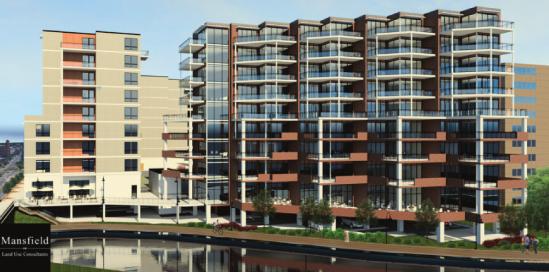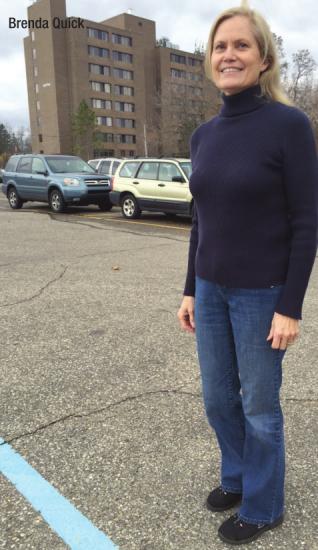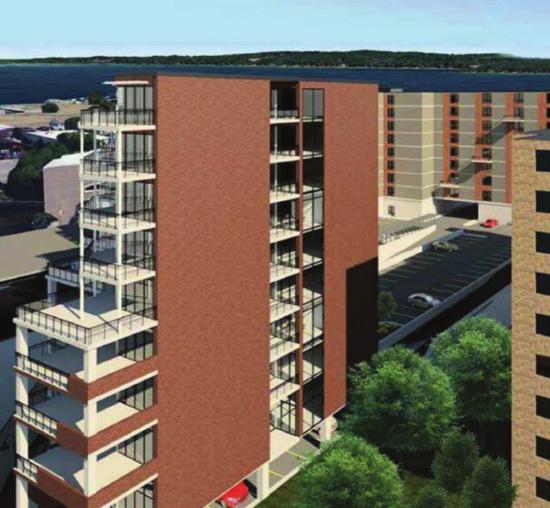Nine Stories of Conflict
 A Tall Building Proposal Pits Young Versus Old In A Battle For The Future of Traverse City
A Tall Building Proposal Pits Young Versus Old In A Battle For The Future of Traverse City Debate over two nine-story buildings proposed at the corner of Front and Pine streets in Traverse City has become about something bigger than whether developers should be able to build a large mixed-used apartment complex — it’s become a debate about the future of Traverse City.
Unlike previous development battles, this one has largely pitted older people who are opposed to tall building heights and want to maintain the city’s small-town character against others who believe such a development is critical to keep a young population in the city.
YOUNG VERSUS OLD
An early November city planning commission meeting, where the proposal moved forward with a 7-2 vote, made it clear that this debate pits young versus old, Northern Michigan Environmental Action Council Co-Chair Greg Reisig said.
One after another, Reisig saw older people get up to argue the height was too tall and the footprint too wide, and younger people speak about the desperate need for good affordable housing.

NMEAC Co-Chair Ann Rogers said the division is heartbreaking.
“It’s so sad,” she said. “I don’t know. I just feel very badly, because those of us that have lived here are being painted as old and wealthy. And we care. This is our city and we should all care. It’s enough to break your heart, really.”
Though it is the height of the building that seems to incite emotional reaction from one side afraid that the city is growing too fast — and excitement on the other, seeing it as a sign of smart growth and density — Rogers said NMEAC opposes the project on environmental grounds.
Brenda Quick, an attorney who lives on Fifth Street who has helped organize a campaign to hold a referendum to cap buildings at 60 feet, believes proponents of River West have fostered the generational rift.
“If you tell people long enough, ‘You know, it’s you against them,’ then eventually some people will start to believe it, and that is just really sad and unfortunate,” Quick said.
She said it is unfair to paint opponents as wealthy retirees who want everything to stay the same. She said she is in favor of affordable housing and would support a 60-foot building at Front and Pine.
She notes that some older people are for the project and some young folks are against it.
“The assumption that all millennials think this is wonderful is just absolutely false,” Quick said.
“WE WERE STUNNED” Quick moved to Traverse City for its character and became an activist when she saw the River West plans.
“I grew up in a metropolitan area. I worked in downtown Detroit for 12 years; I’ve lived in Toledo; I’ve taught in Orlando; I’ve taught in Chongqing, China, which has nine million people,” Quick said.
She said safety, scenic beauty and access to medical care brought her and her husband to Traverse City.
“Quite honestly, we were stunned at the size of the project. It wasn’t just that it was nine stories, but the fact that it’s such a mammoth project. It’s six times the footprint of Riverview Terrace,” she said. “It was one of those, ‘You’ve-got-to-be-kiddingme’ moments.”
Quick can tick off reasons she believes the Special Land Use Permit (SLUP) should not have been granted by the planning commission. River West is proposed for a lot where buildings up to 60 feet are allowed by right and buildings up to 100 feet are allowed with a SLUP approved by the city, meaning projects must meet a detailed list of requirements.
The development will overwhelm the city’s infrastructure in that part of town, she said; it will require too much parking and create too much traffic; it’s too close to a quiet neighborhood.
Ultimately, Quick doesn’t believe the development will appeal to the young professionals or downtown workers who are supposed to want to live there. She said the development will attract a spectrum of people interested in low-income housing. “OK, if you are young, maybe unmarried or don’t have children, you’re in good health and so forth, an environment like that might be extremely attractive to you,” Quick said. “But if you’ve got children, I would never want to send my seven-year old out on a city street to play by himself or herself, so I’m telling my child, ‘No, you can’t go out and play.’”
THE FUTURE OF TRAVERSE CITY
Just as confidently as opponents believe the project doesn’t meet the standards to win permission to build a 100-foot building, supporters, and seven members of the planning commission believe it does.
Co-owner and developer Erik Falconer said he helped design the project with the future of Traverse City in mind so the city could be more welcoming to young adults.
Falconer grew up in Traverse City, graduated from high school in 1991, and brought his job and family home 11 years ago.
Falconer said affordable housing was built into his vision for River West.
“What do we really need? Housing comes up over and over, but not just housing in general. A specific type,” Falconer said. “And having the location be downtown and seeing the opportunities and the potential for what that would bring to the region and to our community — we’re trying to do this for the benefit of the community.”
That such a big project would evoke a big reaction is not a surprise, but Falconer said the age divide is surprising.
“It’s stark,” he said. “What I would hate to see is this devolve into a generational [conflict]. I think that misses the point, which is that this is a beneficial project for the community and provides opportunities and preserves the characteristics of a vibrant community that we’ve come to love.”
Falconer has also noticed the fissure among environmentalists over the project and said the developers have worked with the Watershed Center Grand Traverse Bay and the Soil Conservation District to make sure environmental concerns are satisfied.
Watershed attorney TJ Andrews said the nonprofit watchdog has reviewed and approved the projects’s stormwater control measures and how it would affect the Boardman River shoreline.
Watershed is not taking a position pro or con on the proposal itself.
“From a big-picture environmental perspective, we would rather see more dense development rather than more sprawl development,” she said. “So from that perspective, it’s a good idea, but we’re not going to jump in on this debate on that basis.”
AN ENVIRONMENTAL DIVIDE

The environmental argument in favor of River West is density — that locating workers downtown will reduce car travel and stacking apartments on top of each other reduces the development’s footprint.
Whether River West is good for the environment, though, has split the environmental community. NMEAC and the Traverse City–based Groundwork Center for Resilient Communities often sit at the same side of the table. Not this time.
“It’s hard to figure out, it really is — it’s challenging, complicated, confusing,” said Hans Voss, Groundwork’s executive director, who supports River West.
He said this is just the kind of development that was called for through the Grand Vision, a years-long effort to establish consensus about what the region’s future should look like.
“Making the transition to advocating against something to advocating for something is a real challenge,” he said. “I respect people who say, ‘I don’t want a nine-story building.’ But if you measure it against environmental impacts, there’s no question that it is smart growth. While this specific project may not be perfect and should be held under intense scrutiny, this is density downtown; this is growth downtown.”
Reisig said NMEAC opposes the project because there are too many environmental questions — the proximity to the river, concern that the river is a natural flyway for birds and historical contamination on the property.
Reisig said NMEAC supports affordable housing, but he said if River West must be nine stories to make affordable housing feasible at that location, it’s the wrong place. He wants the issue to go up for a popular vote. “It’s about scale,” he said. “To say that anybody against it is opposed to growth, that’s not true at all.”
“THE YOUNG PEOPLE ARE WRONG”
City Commissioner Gary Howe said he doesn’t believe the issue is as divisive as it seems. There are advocates on both sides who stand up and speak passionately at meetings, but Howe said sharp talk turns moderate in private conversations.
“As you talk more to people and they get it, they step back from the edges,” he said. “You’ve got to be careful, because a lot of older folks don’t mind the project and a lot of younger folks do mind it. But it has hit a nerve among generations.”
Howe supports the project because he believes it is good for the environment and offers the kind of density the city needs.
“One reason I came back was the energy that was happening in Traverse City,” said Howe, who grew up in Traverse City, moved away, and then moved back. “We are a small city and people want to move here. We are a desirable place. You don’t get to shut the door behind you.”
Mayor Jim Caruthers, who won his office this month on a campaign that made opposition to River West its centerpiece, is frustrated by the tone of the debate.
“I think it was made a political issue and the divisiveness was made on social media,” he said. “I’m tired of the phone calls.
I’m tired of the pitting of the young people against the old people.”
Caruthers said he’s also been surprised by the divide among environmentalists.
“They’re choosing to believe that buildings like this are going to stop sprawl.
They are not going to stop sprawl,” he said. “They’ve led people to believe it’s just going to be the end-all-be-all for affordable housing, which it isn’t.”
NMEAC board member Bill Scharf, a biology professor at Northwestern Michigan College for 30 years before he went on to other schools and returned to Traverse City to retire, is also opposed to River West.
Scharf said the building is too close to the river, which thrushes and warblers use as a migration pathway. The birds will get killed when they fly into the windows of the tall buildings, he said.
Scharf said the young/old divide doesn’t concern him.
“Sure, I’ve noticed. I just think that the young people are wrong, that’s all,” he said. “Ask the young people how it will be to be in this urban canyon with no sunlight.”
“NEW URBANISM AS A RELIGION”

No one argues that River West would halt sprawl, but Michael Grant, an attorney who used to work for NMEAC and is a proponent of smart growth, said the project has a better chance at stopping some sprawl than the high-end condo developments sprouting around the city because it will provide housing for people who live in the city year-round. Grant said he doesn’t understand the environmentalists who are opposed.
“You’re talking about people driving less, heating and cooling less, less asphalt, etc., etc. I mean, that’s where I get frustrated,” he said. “You can say with some pretty good numbers behind it that this is an environmental winner.”
John Di Giacomo, an intellectual property lawyer and member of the Downtown Development Authority, doesn’t believe environmentalists opposed to River West have good arguments.
“I think it’s disingenuous to say opposition to this is about the environment,” he said. “It’s about, ‘I don’t like it.’” Di Giacomo hopes River West will attract young professionals to Traverse City.
He’s offered jobs to young lawyers who turned them down over lack of housing.
“If we can’t attract those types of people, especially the types of businesses like mine, which is location independent, or like Mac- Update, which is also location independent, we don’t stay here,” he said. “That’s a real risk over the long term.”
Attorney Grant Parsons, who helped stop a big downtown development in the 1980s, the Buffalo Mall, sees parallels between that mall and River West.
“They made the argument that if we don’t have a downtown mall, we are going to fail as a city,” Parsons said. “Today, that property is worth about $30 million and they were going to give it away.”
Parsons, who has worked with Quick on the referendum, said he is frustrated by the division the project has caused.
“I have a reasonable amount of respect for new urbanism as one zoning tool or one city planning tool, but I don’t respect it as a religion,” he said. “Hans Voss, Mike Grant, some good people, they are adopting new urbanism as a religion.”
WHAT’S PROPOSED AT 305 FRONT?
River West would be a pair of buildings featuring ground floor retail and 162 living units. Of those, 64 are slated as “workforce” apartments to be rent-subsidized through the Michigan State Housing Development Authority. The remaining 98 units would be available at market rate and would range from small with unremarkable views to large with vistas of Grand Traverse Bay. The building would also include 177 parking spaces and 132 spaces for bicycles. River West would be approximately the same height as Riverview Terrace, a 10-story apartment building that’s been on an adjacent lot since the 1970s.
View On Our Website